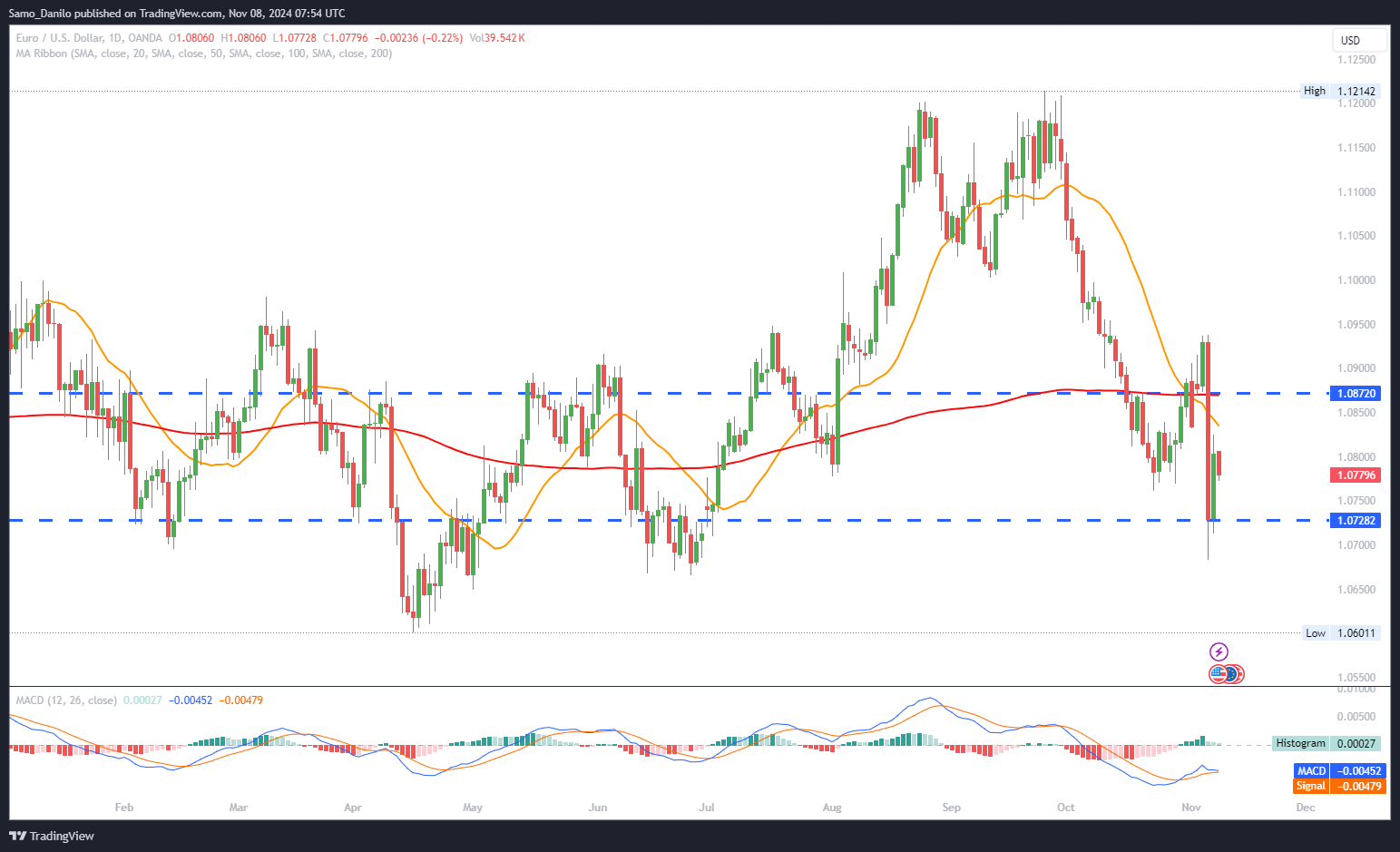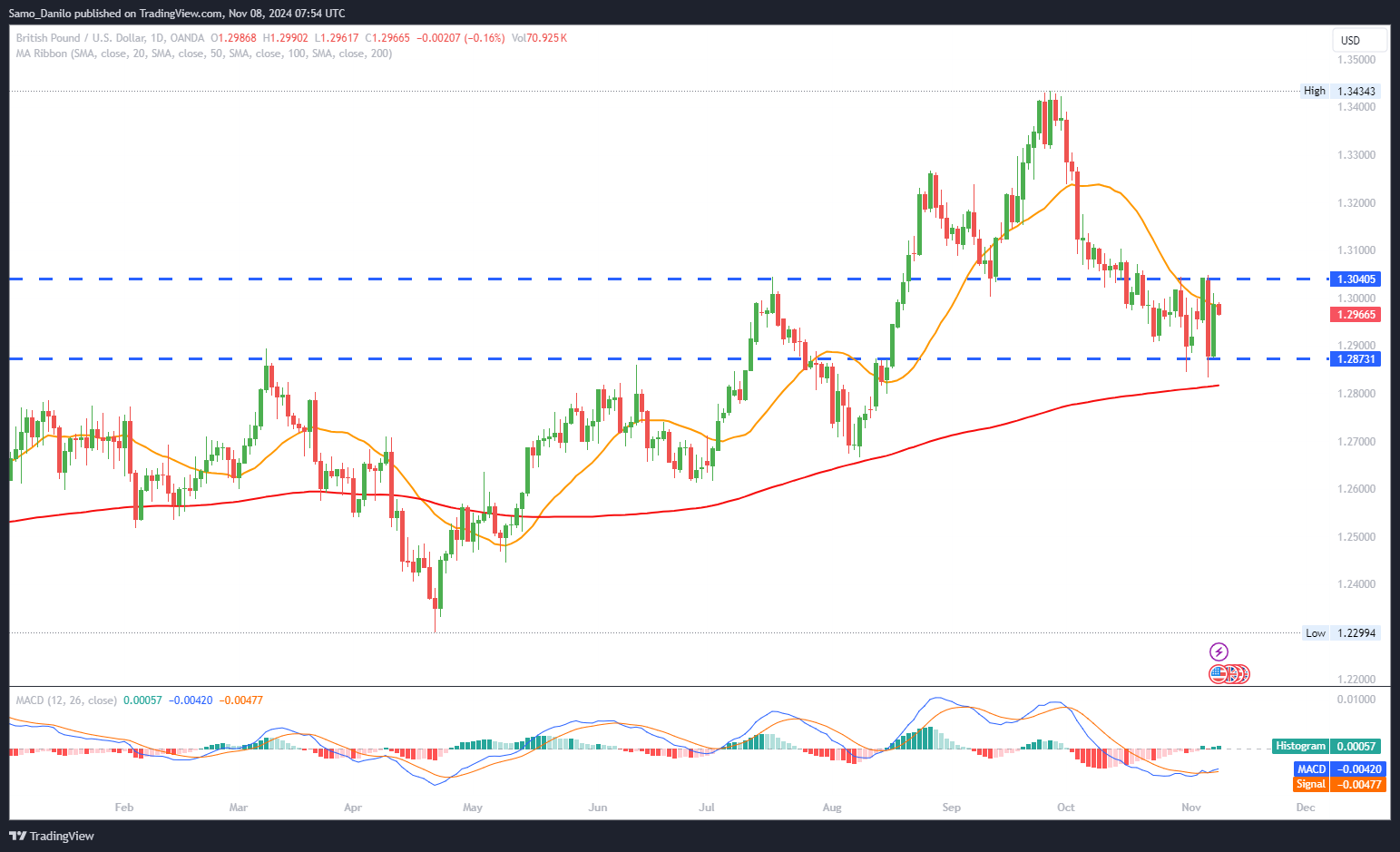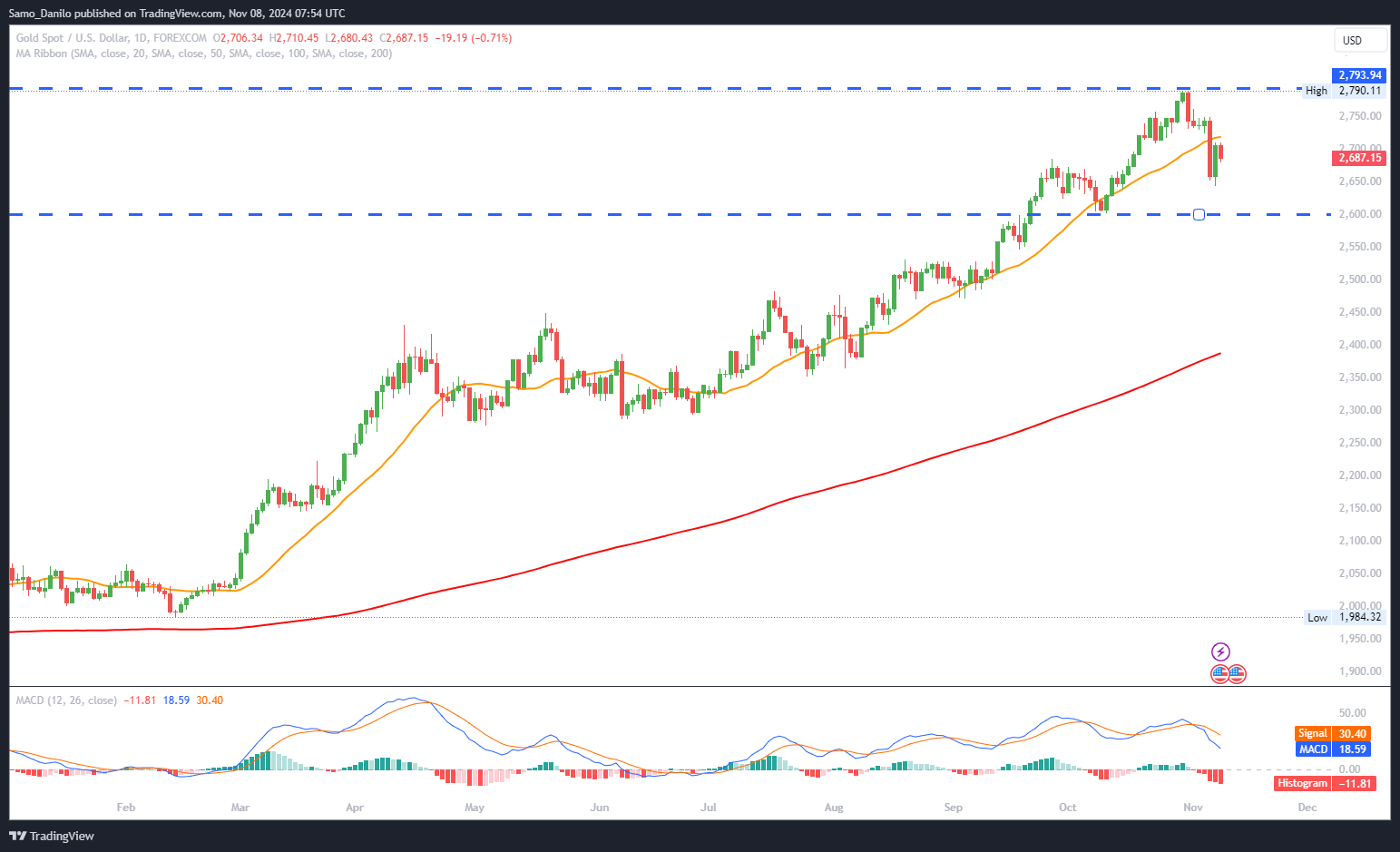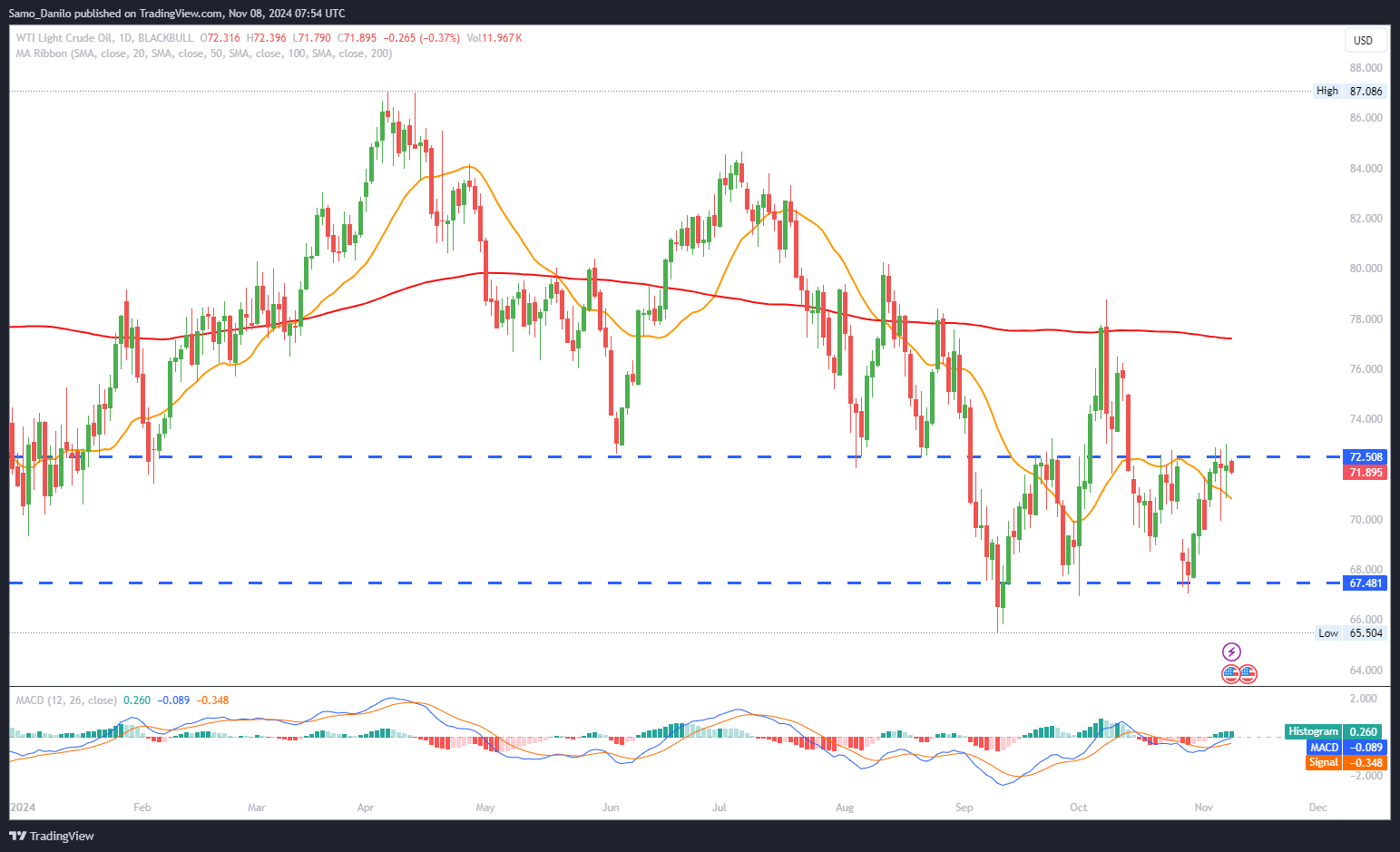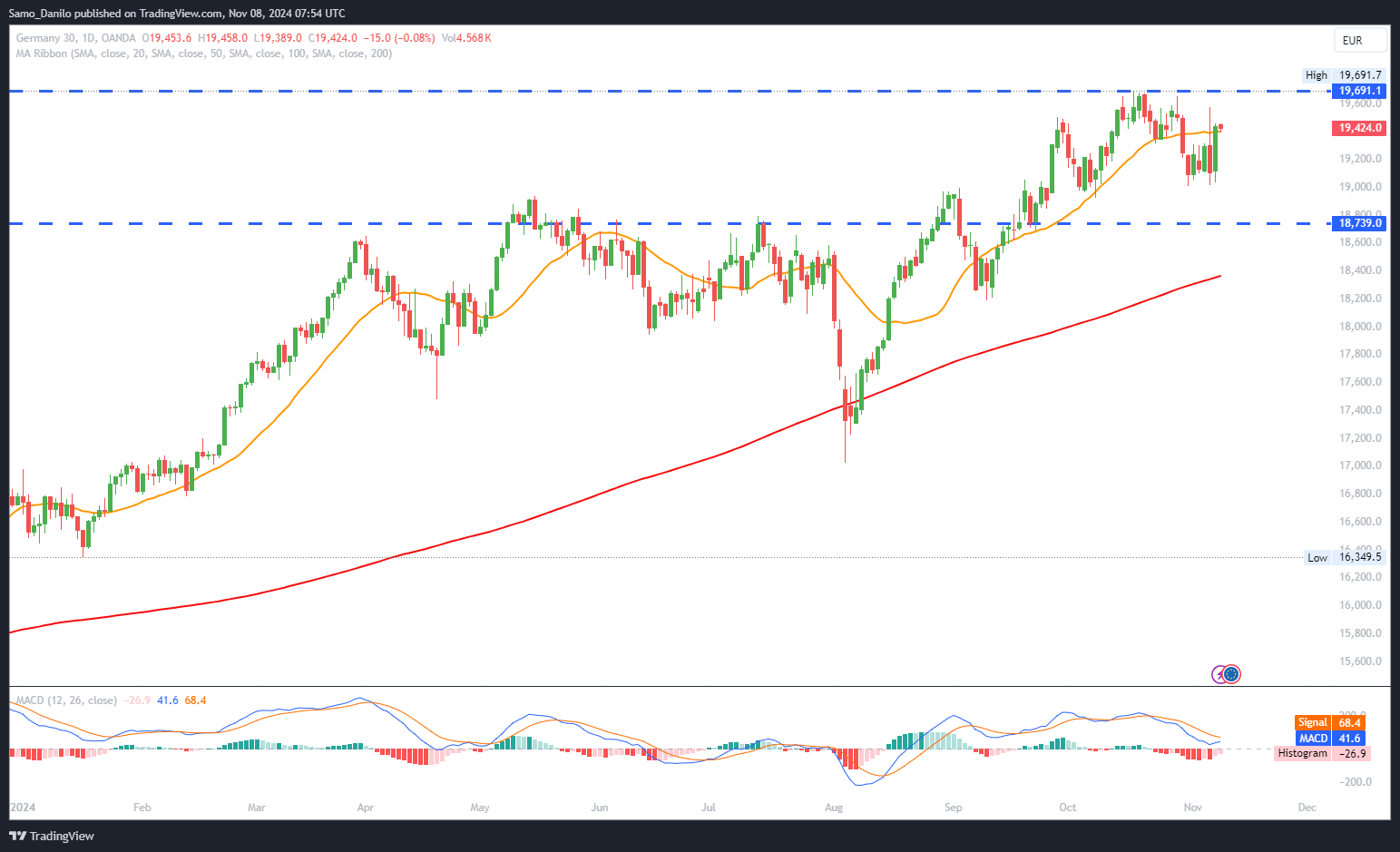EURUSD
- EUR/USD Movement: The EUR/USD pair is currently trading below 1.0800 during Friday’s European session, reflecting a renewed strength in the US Dollar and a cautious trading atmosphere. This marks sustained pressure for the Euro in the face of dollar demand.
- Fed Rate Cut: On Thursday, the Federal Reserve cut its Fed Funds Target Range by 25 basis points, bringing it down to 4.75%–5.00%. This anticipated move signals the Fed’s continued focus on managing inflation without overextending into more aggressive rate adjustments.
- Fed’s Outlook on Economy: In its statement, the Fed noted that inflation and employment risks are "roughly in balance," aligning with September’s policy language. This outlook implies a wait-and-see approach, suggesting stability in the short term.
- Future Fed Policy: Federal Reserve Chair Jerome Powell emphasized that no final decision has been made regarding policy moves in December. This uncertainty leaves room for data-dependent adjustments, especially as the Fed evaluates future economic conditions.
- ECB's Rate Cut: The European Central Bank recently reduced its deposit rate to 3.25%, with officials signalling hesitation on further cuts. ECB policymakers seem to prefer waiting for additional economic data before making further decisions, reflecting a cautious approach.
Closing statement: The EUR/USD remains under pressure as the Fed and ECB maintain data-driven strategies, leaving the pair vulnerable to further volatility. Any firm signals on December policy direction from either central bank could steer the pair, with particular attention to US Dollar strength and evolving Eurozone data.
GBPUSD
- GBP/USD Movement: The GBP/USD pair has softened toward 1.2950 in early Friday European trading. Renewed interest in the US Dollar, coupled with a cautious market sentiment, has weighed on the British Pound.
- Fed Rate Cut: The Federal Reserve’s recent 25-basis-point rate cut, lowering the target range to 4.50%—4.75%, reflects a balanced approach to inflation and employment risks. Fed officials emphasized an uncertain economic outlook, indicating a readiness to adjust as new data emerges.
- BoE’s Rate Cut: The Bank of England followed suit with a 25-basis-point rate reduction but raised its inflation forecast, implying concerns about persistent inflationary pressures. Labour’s latest budget release further complicates future policy decisions for the BoE.
- Governor’s Stance: BoE Governor Andrew Bailey reiterated the importance of a gradual approach to policy easing, indicating a measured stance amid evolving economic conditions. This conservative approach suggests potential caution in future rate cuts.
- Focus on US Data and Fedspeak: Traders will look to Friday’s US Michigan Consumer Sentiment data and remarks from Fed’s Michelle Bowman for guidance. These events could influence near-term USD movements and, subsequently, the GBP/USD pair.
| SMA (20) | Falling |
|
|
| RSI (14) | Slightly Falling |
| |
| MACD (12, 26, 9) | Falling |
|
|
Closing statement: GBP/USD remains pressured as diverging economic strategies between the Fed and BoE impact market sentiment. With key US data and Fed commentary ahead, the pair may see volatility, especially if US economic resilience supports further USD strength.
GOLD
- Gold Price: Gold price turned lower early Friday, reversing gains made after a 3% decline spurred by Trump’s presidential win. Persistent USD strength weighs on Gold, as markets continue to assess the implications of Trump’s policies.
- USD Reaction: Following a brief USD uptick in response to the Fed's rate decision, Chairman Jerome Powell’s cautious outlook during his press conference led to a swift reversal. Powell’s acknowledgment of economic uncertainties has added an element of restraint to the USD’s strength.
- Powell’s Position: Powell cited improving economic indicators that may mitigate some negative risks, while emphasizing the Fed’s limited ability to provide forward guidance amidst prevailing uncertainties. His firm stance to remain in office under the Trump administration reinforces a sense of stability within the Fed’s leadership.
- Market Interpretation of Trump: Traders anticipate that Trump's proposed immigration restrictions, tax reductions, and tariff adjustments could drive inflationary pressures higher. This belief has underpinned recent USD strength, with potential inflation growth prompting a cautious yet strategic shift toward safe-haven assets like Gold.
- Upcoming US Data: With critical US consumer sentiment and inflation expectations data due Friday, the USD and Gold markets may experience heightened volatility. As positioning readjustments take place, traders will closely watch these figures alongside the awaited CPI data for indications on inflation trends.
| SMA (20) | Rising |
|
|
| RSI (14) | Falling |
|
|
| MACD (12, 26, 9) | Slightly Falling |
|
Closing statement: Gold remains under pressure as markets absorb potential inflation risks under Trump’s presidency and closely monitor Fed policies. Key data releases and expectations for sustained USD strength may keep XAU/USD biased toward the downside in the near term.
CRUDE OIL
- WTI Price: West Texas Intermediate (WTI) crude maintains stability around $71.70 per barrel on Friday, securing a weekly gain of over 3%. The price resilience reflects market optimism despite global demand concerns.
- Fed’s Rate Cut: The Federal Open Market Committee (FOMC) reduced interest rates by 25 basis points to a range of 4.50%–4.75%, signaling continued focus on stabilizing the US economy. While rate cuts can typically spur economic activity, they may also put upward pressure on commodity prices as the dollar weakens.
- Potential US Sanctions: Comments from Andrew Lipow of Lipow Oil Associates highlight the market’s expectation that Trump’s administration might increase sanctions on Iran and Venezuela, which could reduce global oil supply, supporting prices.
- Production Disruptions in Mexico: Hurricane Rafael has led to production cuts in the Gulf of Mexico, constraining US supply and supporting crude prices. Ongoing weather- related disruptions may add additional pressure on US production levels.
- Chinese Oil Imports: China’s crude oil imports fell 9% in October, marking a six-month decline in year-on-year imports. This contraction in one of the world’s largest oil markets introduces potential demand-side concerns for global oil prices.
| SMA (20) | Slightly Rising |
|
| RSI (14) | Slightly Rising |
|
| MACD (12, 26, 9) | Slightly Falling |
|
Closing statement: While WTI crude oil is buoyed by expectations of supply constraints from sanctions and production cuts, softer demand indicators from China present a headwind. Near-term outlook remains cautiously optimistic, contingent on geopolitical developments and sustained supply pressures.
DAX
- DAX Rebounds: The DAX climbed 1.70% on Thursday, reversing earlier losses. Gains were partly driven by political shifts, as Chancellor Olaf Scholz removed his finance minister, fueling hopes that a new, potentially less fiscally conservative minister might increase spending, positively impacting market sentiment.
- Auto Sector: German auto stocks, led by BMW and Daimler Truck Holding, rose by 2.92% each as the sector bounced back from declines following Trump's US election win. Renewed confidence in the auto industry reflected optimism that geopolitical risks may not impact EU auto exports as harshly as initially feared.
- Weak German Data: Recent data showed a 1.7% drop in German exports and a 2.5% decline in industrial production for September, indicating ongoing economic challenges. These figures highlight structural issues within Germany's economy and could temper long-term growth expectations for DAX-listed firms.
- US Data: US initial jobless claims edged up slightly to 221k, aligning with expectations for a “soft landing” in the US economy. Steady US labor market indicators may support investor confidence in a stable macroeconomic backdrop, benefiting the DAX as well.
- Fed Rate Cut: The Federal Reserve’s decision to cut interest rates by 25 basis points after European market hours bolstered equity markets, as lower borrowing costs are expected to enhance corporate earnings potential, which could further uplift DAX-listed stocks.
| SMA (20) | Rising |
|
|
| RSI (14) | Slightly Rising |
| |
| MACD (12, 26, 9) | Slightly Falling |
|
Closing statement: The DAX’s upward trend is supported by political changes and resilient auto sector recovery, although weak domestic economic data may weigh on long-term growth. Further fiscal easing from both the Fed and potential German policy shifts could provide a favourable environment for DAX performance.
